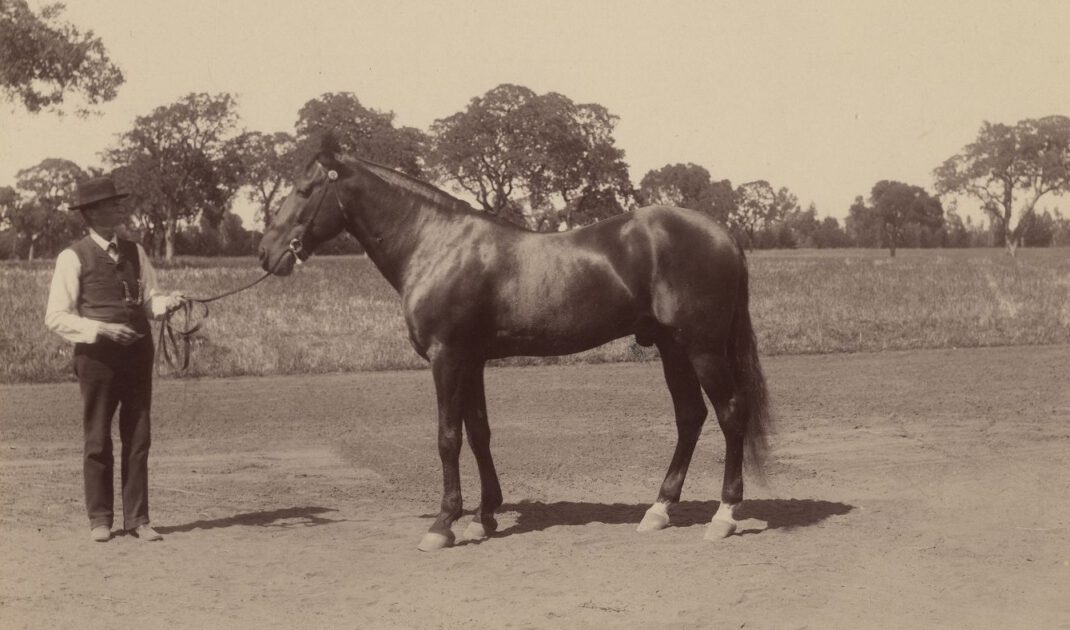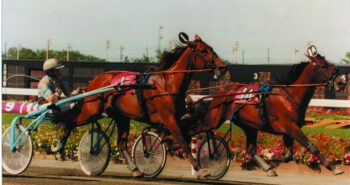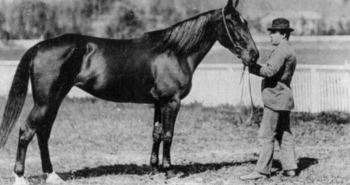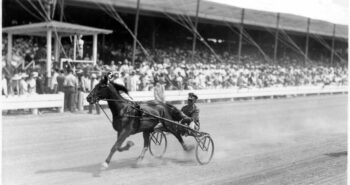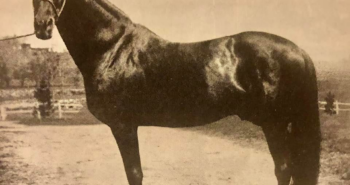He was broken, but never trained for a single race. When Electioneer was bought at 8 for a huge sum he had nothing to show for and buyer Leland Stanford was told by numerous people he had gambled on the wrong horse. As it turned out, however, it was Stanford who was right and everybody else who was wrong as Electioneer turned out to be the premier sire of trotters in the high-wheel sulky time.
In 1876, Leland Stanford purchased the 650 acres Rancho San Francisquito. He added other land and developed the 1800 acres Palo Alto Stock Farm. Originally from New York, Stanford had migrated to California during the Gold Rush and amassed great wealth, mostly from his role as president of the Central Pacific Railroad. Stanford was one of many wealthy men considered to be a “robber baron”, a term in the late 19th century used to describe businessmen who used exploitative practices and corruption to greatly enrich themselves. Stanford was also governor of California from 1862 to 1863 and later US senator from 1885 to his death on Jun 21, 1893.
A baffling purchase
The filthy rich man wasted no time buying some of the best broodmares of the land for his Californian farm. On Dec 2, 1876, the tycoon visited Charles Backman’s Stony Ford farm, picked out 13 horses and, upon hearing the total price would be $41,200 simply responded “I will take the lot.” The highest price, $12,000, was paid for the 8-year-old Electioneer. According to a newspaper report, “There was no talk of reduction in price, the purchaser recognizing the rates as reasonable for such stock. Mr Backman subsequently made Governor Stanford a present of three finely bred yearling fillies.”
According to one article circulating in US newspapers a few months after Electioneer’s death, the story of the stallion’s purchase was as follow:
The story is that a great dinner party was arranged at Stony Ford in view of the possible purchase of Mr Stanford of Messenger Duroc. The price demanded was $60,000. After the dinner, Senator Stanford was invited to look at Messenger Duroc.
He scrutinized the high-prized animal carefully for a few moments and then dismissed him with the brief comment that he “looked narrow.” Then the senator went into Electioneer’s stall. The brown stallion’s muzzle was turned away when the Californian entered the stall. After a moment Electioneer turned his intelligent face and wonderfully lustrous eyes and took a calm survey of his visitor.
“Is there a price on this horse?” asked Mr Stanford.
“Yes, $10,000,” was the reply.
“Good enough,” said the senator. “I’ll take him.”
Leland Stanford himself gave a slightly different account in the Breeder and Sportsman:
“It was about the time I had decided to increase my establishment at Palo Alto. I was induced to go over to Stony Form stud farm, at Orange, NY, and look over some Hambletonian broodmares owned by Mr Backman. I spent three or four days making my selections, and on every occasion that presented I scanned Electioneer. The more I saw of him the better I liked him; but I expressed no public view to buy him. A party of gentlemen were with me, and I would casually call their attention to him to draw out their criticisms. They were given freely, and were generally unfavorable to the horse. I kept my counsel, and on the morning of the day I was to leave I handed Mr Backman the list of horses I wanted, and in the list was Electioneer. My friends were astonished. They could not see what I wanted of that horse, with heavy shoulders like a cart horse and with high hind quarters like a steer. There was his stable companion, Messenger Duroc, who had achieved national fame by siring Prospero, a very fast and game animal, and he had also got other good ones, of which there was no question. It did look a little risky, but I paid my $12,000 just the same, and in due time he reached his future home.”
Stanford shelling out this much money for Electioneer was a surprise as the colt had never raced. He was blue-blooded as a son of Hambletonian and Green Mountain Maid, but was a complete unknown, as he had never been trained and only covered a few mares. For this reason, several people – including Backman himself – supposedly told Stanford he’d made a mistake and urged him to reconsider. However, when the Californian had made up his mind he stubbornly stood by his opinions.
The right type of mares
It didn’t take Electioneer long time to establish himself as a top stallion – and prove that Stanford was correct in ignoring the advice. In November 1880, his son Anteeo set a yearling world record by trotting in 3:17 1/2 (2.02,8) at Oakland Park. Not exactly fast when compared to two- and three-year-olds, but Anteeo beat his competitors by “a good hundred yards.” The achievement underscored Stanford’s belief in crossing trotters with runners as Anteeo’s dam was a thoroughbred. This was a big part of his breeding philosophy – and he truly didn’t care for the opinions of those who told him to breed trotters to trotters.
In December 1878, the following little piece was printed in newspapers nationwide: “Ex-Gov Leland Stanford of California, has not been influenced in the least by the articles of the “critics” who pronounce against thoroughblood in the trotter. His superintendent is now in Kentucky selecting two car loads of thoroughbred mares to the shipped to the Pacific coast. The Governor will breed to Electioneer, purchased at Stoney Ford, and he will allow his Hambletonian mares to receive the embrace of a thoroughbred stallion, probably a son of the race-horse Belmont. He wishes to lay solidly the foundation of his trotting stud. He may not live to see his policy bear its ripest fruits, but he has the satisfaction of knowing that California will be benefited by it in the end. The Governor is a clear-headed man, and he is proud of the development of his State.”
Still, Anteeo was just a taste of what was to come. Stanford had his superstar stallion, but he also realized the problem the colt presented breeding-wise. Stanford later explained that “for the first two or three years Electioneer did not have much of a show in the stud. You see, my ranch was largely stocked with Hambletonian mares, and I did not think it good policy to cross him with his own blood. I had already in the stud Piedmont and General Benton, both good horses, and in order to give Electioneer a show I had to increase my purchases of mares from time to time and to take great pains in my selections of them.”
Breaking all the records
In October 1881, existing records for three-year-olds were blown out of the water by the Electioneer-daughter Wildflower when she time trialed in 2:21 (1.27,6). This beat the “Eastern record” by a whole ten seconds – no wonder the newspaper headlines in California simply read “Send the news to Kentucky immediately.” The previous year Fred Crocker. another son of Electioneer, had also beaten the Eastern record when trotting in 2:25 1/2 (1.30,4). Within 12 months, Anteeo’s yearling record was also a thing of the past. After several horses had shaved some seconds off it, Hinda Rosa demolished it completely when she trotted in 2:43 (1.41,3). Unlike the many Stanford-bred horses with a thoroughbred maternal side, Hinda Rosa was out of the trotting mare Beautiful Bells 2:29 1/2 (1.32,9).

The early successes were just a forewarning of what was to come, though. Later Electioneer would sire three horses to beat 2:10 (1.20,8). In October 1891, two-year-old Arion time trialed in 2:10 3/4 (1.21,3) at Stockton, causing some newspapers to pronounce the colt “the eight wonder of the world.” It was the final two-year-old world record in the old time of high-wheel sulkies. At the same time, the mare Sunol set an absolute world record 2:08 1/4 (1.19,7) at the age of 5 – again, the last absolute world record set with a high-wheel sulky
The following month the Electioneer-son Palo Alto trotted 2:08 3/4 (1.20,0). This was the stallion record and meant Electioneer and Stanford’s Palo Alto held all the records:
- Bell Bird, by Electioneer and Beautiful Bells, had the yearling record in 2:26 1/4 (1.30,9).
- Arion, by Electioneer and Manette, had the two-year-old record in 2:10 3/4 (1.21,3).
- Sunol, by Electioneer and Waxana, had the three-year-old record in 2:10 1/2 (1.21,1).
- Sunol also had the four-year-old record in 2:10 1/2 (1.21,1).
- Sunol also had the five-year-old and all age record in 2:08 1/4 (1.19,7).
- Palo Alto, by Electioneer and Dame Winnie, had the stallion record in 2:08 3/4 (1.20,0).
Adding to his immense siring abilities, Stanford also admired the stallion’s temperament. He would later recall the following in the Breeder and Sportsman:
“He was so sensible, so affectionate and so obedient. He loved to be petted by ladies. They would drive up to him in their carriages. The groom would lead the old horse out of the stable and he would eagerly push his nose into their laps and beg for caress. To men he was more playful, but never vicious. None of his get that have been humanely treated have shown vicious qualities. He has almost uniformly impressed upon his offspring his great mental as well as physical qualities.”
Revolutionary training methods
There is no doubt that the Palo Alto Farm had a fantastic stallion in Electioneer and possibly the best collection of broodmares at the time. However, what really separated Stanford from most others was his belief in developing trotters early. At the time, people simply didn’t develop early speed. In 1876, when Electioneer was purchased to California, no two-year-old had broken the 2:40 barrier, and the three- and four-year-old records stood at 2:29 (1.32,6). The universal belief was that training and racing young horses were detrimental to their development and well-being. Two years prior, in 1874, Goldsmith Maid had lowered the world-record to 2:14 (1.23,3). The mare was 17 years old at the time, having been broken to trot at eight. Trotters were broken late and then developed using lots of hard work and weight on their feet.
Leland Stanford however, believed trotters should be born trotters and not made. Being an insanely rich man, he had the ability to finance his ideas being realized to the fullest – and it didn’t take long for the rest of the world to come around to his way of thinking. At Palo Alto Stanford and his trainer Charles Marvin developed their own system focusing on developing early speed and a natural gait. Consequently, Stanford didn’t allow his any of his horses to wear a toe-weight or an overcheck, as well as insisting that the horses we driven with a light hand and not being forced to go forward. The weanlings and yearlings were handled often, broke to harness early and trained using shorter intervals with brushes of speed at the end. This was often referred to as the “Palo Alto system”, sometimes also as “the brush system,” which was a rudimentary interval training.
It was no different when it came to the stallions at the farm. Conventional wisdom at the time suggested that stallions would get better foals if their energy and vitality weren’t drained by exercise, training or racing. Consequently, many just stood in a stable day in and day out. Not so with Electioneer, who was driven daily. In training he could easily trot a quarter in 34 seconds, and trainer Charles Marven believe the stallion could easily trot in 2:20 (1.27) if he was set up for that.
An intense hate
It is easy to see why the contemporaries considered Electioneer to be the best trotting stallion who ever lived. The key word is “trotting”, because Stanford dislike for pacers was bordering on hate. Pacers simply weren’t welcome at the farm. The wealthy man would long assert that Electioneer never sired a pacer. He was almost correct. Of the 160 Standard performers, 158 were trotters. Peruvian Bitters p2:23 1/2 (1.29,2) was given his pacing record, according to rumors at the time, on the insistence of an owner who had a deep grudge against Stanford. The other pacer, Solano p2:25 (1.30,1), set his record several years after Stanford’s death.
Two months after Palo Alto’s record run, on Jan 12, 1892, it was announced that J Malcolm Forbes had bought Arion, “the greatest two-year-old the world has ever seen”, for a massive $150,000. Then, in late July 1892, Palo Alto died of pneumonia after being sick for nearly two weeks. The death was particularly tough on Leland Stanford, who held Palo Alto very dear. Later that year, Sunol’s world record was a thing of the past as Nancy Hanks bettered it by a full second when using a modern sulky. Many thought Arion would better this, but he “only” trotted 2:07 3/4 (1.19,4) with a modern sulky in 1893. This was nonetheless a record for a four-year-old at the time.
An undesired legacy
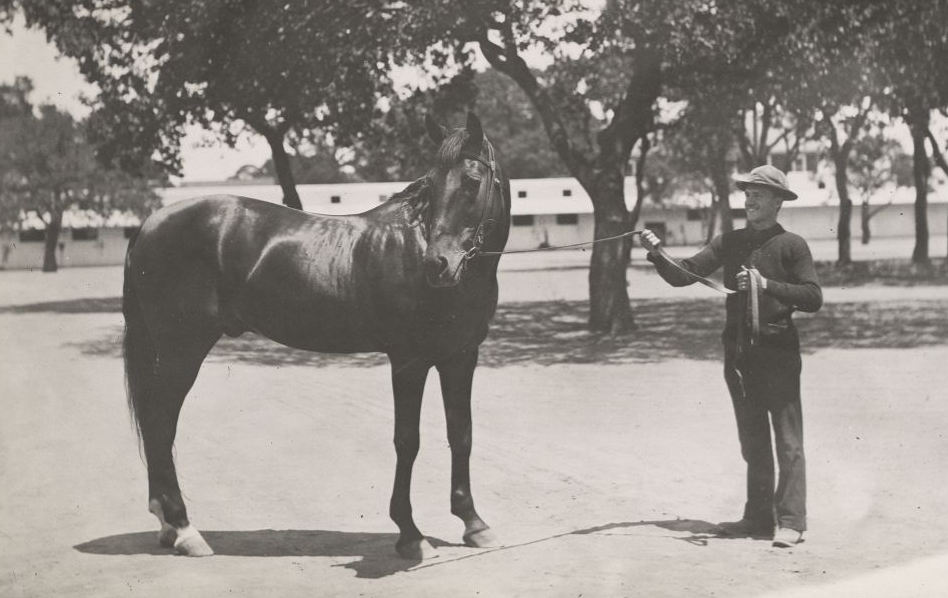
The Electioneer family was a powerhouse of trotting, but it wouldn’t remain so for long. Chimes, by Electioneer and the above-mentioned Beautiful Bells, sired the brilliant pacer The Abbe, who is the paternal grandsire of Hal Dale p2:01.2 (1.15,4). The latter sired legendary pacer Adios and is also the paternal grandsire, through Dale Frost, of Meadow Skipper. How ironic isn’t it that the most prized possession of Leland Stanford – who couldn’t stand pacers – is the paternal origin of most current pacers? The only competition, sireline-wise, on the pacing side comes from Volomite; the sireline through his son Sampson Hanover p1:56.4 (1.12,6) continues to the legendary Somebeachsomewhere.
However, as it turns out, without Leland Stanford there wouldn’t be a Volomite: when Stanford sent his trusted farm superintendent Harrison Covey to Kentucky to buy thoroughbreds for crossing with trotters in December 1878, his orders, according to John Hervey’s article Electioneer a Phenomenon of Standardbred breeding, in Harness Horse from February 12, 1936, were for Covey to select mares that “(1) were in conformation best suited to cross on Electioneer, (2) were bred in lines of running blood that had shown a tendency to cross well with trotting blood, and (3) were intelligent, tractable and with heads indicating good temper and kindness. Covey selected 40 mares and one stallion. Covey clearly picked well, as one of the mares was Dame Winnie, dam of Palo Alto and maternal great-grandam of Belwin. Another was the two-year-old Esther. Bred to Electioneer she produced the fast Expressive 3,2:12 1/2 (1.22,2). Later, in 1899, she gave birth to the unraced Mendocita, by the Electioneer-son Mendocino. Bred to the stallion San Francisco, Mendocita produced Cita Frisco, the dam of Volomite, by many considered the most influential standardbred stallion in the 20th century. Sunol’s grandam Waxy was a thoroughbred, thus also confirm Stanford’s belief in getting thoroughbred blood crossed in close. Stanford bred numerous such crosses, and quite a few became good trotters.
Such is the influence of Electioneer, a horse that, at first, only Stanford believed in – but, as history repeatedly tells us, sometimes one single supporter is all that is needed.
Electioneer died at Palo Alto farm on Dec 3, 1890 (the date is often erroneously quoted as Dec 4, but this is the day it was reported in the US newspapers). He had been sick for a while, suffering from rheumatism which finally caused his death. At the time of his death, Electioneer had 61 sons and daughters in the 2:30 (1.33,2) list – this at at a time when most stallions only managed a handful.
ELECTIONEER
Bay colt born in Orange County, NY on May 2, 1868. Died at Palo Alto, CA on Dec 3, 1890.
Hambletonian – Green Mountain Maid (Harry Clay)
unstarted
Breeder: Charles Backman/Stony Ford Farm
Owners: Charles Backman – Leland Stanford
Trainer: –
Driver: –
Groom: –

